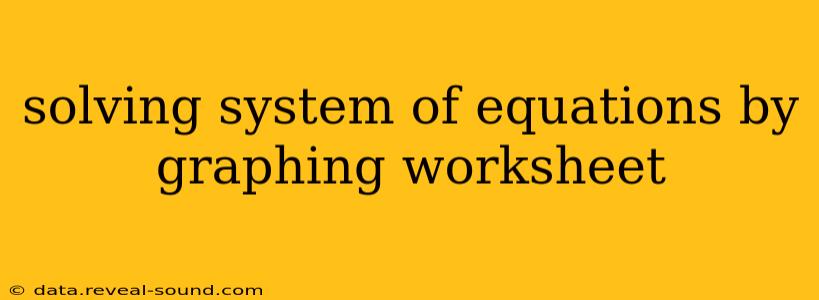Solving systems of equations is a fundamental concept in algebra, with applications spanning various fields. Graphing provides a visual and intuitive method to find the solution, representing the intersection point of two or more lines. This worksheet guide will equip you with the skills and understanding needed to master this technique. We'll cover the basics, explore common challenges, and offer tips for accuracy.
What is a System of Equations?
A system of equations is a set of two or more equations with the same variables. The goal is to find the values of the variables that satisfy all equations simultaneously. For example:
- Equation 1: y = x + 2
- Equation 2: y = -x + 4
This system represents two lines. The solution to the system is the point where these lines intersect – the (x, y) coordinates that satisfy both equations.
How to Solve Systems of Equations by Graphing
The process involves these steps:
-
Graph Each Equation: Rewrite each equation in slope-intercept form (y = mx + b), where 'm' is the slope and 'b' is the y-intercept. This makes plotting the lines easier. Plot the y-intercept on the y-axis, then use the slope to find additional points on the line.
-
Identify the Intersection Point: Look for the point where the two lines intersect. This point represents the solution to the system of equations.
-
Verify the Solution: Substitute the x and y coordinates of the intersection point into both original equations. If both equations are true, you've found the correct solution.
Example:
Let's solve the system from above:
- Equation 1: y = x + 2 (Slope = 1, y-intercept = 2)
- Equation 2: y = -x + 4 (Slope = -1, y-intercept = 4)
By graphing these lines, you'll find they intersect at the point (1, 3). Let's verify:
- Equation 1: 3 = 1 + 2 (True)
- Equation 2: 3 = -1 + 4 (True)
Therefore, the solution to the system is x = 1 and y = 3.
Common Challenges and How to Overcome Them
1. Lines are Parallel:
If the lines are parallel, they will never intersect. This means the system has no solution. Parallel lines have the same slope but different y-intercepts.
2. Lines are Identical (Coincident):
If the lines are identical (they overlap completely), there are infinitely many solutions. This happens when both equations represent the same line – they have the same slope and the same y-intercept.
3. Inaccurate Graphing:
Hand-drawn graphs can lead to inaccuracies. Use graph paper and a ruler to minimize errors. Small errors in plotting can result in a slightly incorrect intersection point.
How to Improve Accuracy in Graphing
- Use Graph Paper: Graph paper provides a precise grid for plotting points.
- Choose an Appropriate Scale: Select a scale that allows you to plot all points clearly and accurately within the given space.
- Check Your Work: After plotting each line, check a few points to make sure they lie on the line.
- Use a Ruler: Use a straight edge to draw your lines.
- Consider Using Technology: Graphing calculators or online graphing tools provide more accurate results.
What if the equations are not in slope-intercept form?
If the equations are not in slope-intercept form (y = mx + b), you need to rearrange them before graphing. For example, an equation like 2x + y = 4 needs to be transformed into y = -2x + 4.
Solving Systems of Equations with More Than Two Variables
While graphing is primarily used for systems of two equations with two variables, understanding this method lays the groundwork for solving more complex systems using other algebraic techniques.
This worksheet guide provides a solid foundation for understanding and solving systems of equations by graphing. Practice is key to mastering this method and building confidence in your algebraic skills. Remember to always verify your solutions!
